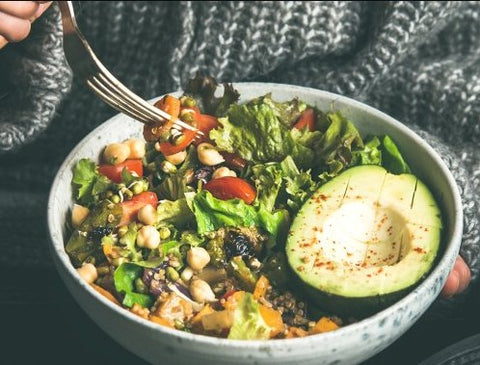On a scale of one to absolutely essential, how important to you is food texture? Perhaps there’s a certain snack that makes you shudder—maybe it’s chewy, tough, and uncomfortable to eat. Or maybe there’s a consistency you can’t get enough of, something you look forward to sinking your teeth into. Maybe you’re indifferent, one way or the other.
For those struggling with their sense of smell and taste due to COVID-19, though, we couldn’t help but notice a trend towards texture—anecdotal, of course, but an uncanny pattern nonetheless. Not everybody who experiences this symptom has the exact same food affinities (or aversions); everyone has different food preferences, after all.
The point is, there’s a significant number of people relying on texture to compensate for other sensory signals—which makes us wonder if they’ll continue to reach for foods based on mouthfeel.
In other words: Will texture become the new taste?
Why is food texture important for some but not others?
We should note that many people have had strong feelings about food texture, long before COVID—some shudder at a plate full of fluffy scrambled eggs or the slime oozing from a slice of okra; others aren’t bothered.
The why largelyremains a mystery within the scientific community, but many experts believe it has to do with memories. You may have had a certain experience with food when you were young, whether it’s burning your tongue or watching a family member respond to food in a certain way that left you with—for lack of a better term—a bad taste in your mouth. Then when 10, 20, 30 years go by, you forget the experience and can’t explain the repulsion.
Of course, the flip side can happen with textures you gravitate toward. Say, if you loved digging your teeth into a certain snack when you were a baby, that crunch can stimulate your brain in a familiar, positive way as you age.
Another reason? “It’s the way somebody is genetically or biologically wired,” says board-certified psychiatrist Anna Yusim, M.D. “And everyone’s wired just a little bit differently,” just like a host of other personality traits. Advertisement
How COVID-19 has affected taste and smell—and why it matters.
Since the onset of the COVID-19 pandemic, a large portion of people have faced loss of smell, a condition called anosmia. Research has shown that 80% of those with acute COVID experience this symptom, and another recent study found people can still lack a sense of smell for up to five months after infection. Some COVID patients have also experienced parosmia, where they experience a distorted—often unpleasant—sense of smell. And a small percentage of people still do not have their senses of smell and taste back—which is why the CDC included these two sense problems among their list of long-term effects of COVID-19.
If you’ve experienced these symptoms firsthand, or have spoken to anyone who has, they might have told you: Eating can be unenjoyable, sometimes even anxiety-provoking. According to Yusim, this happens because your sense of smell is intimately connected to your mood. In fact, research has shown that loss of smell is a significant risk factor for anxiety and depression: “People who have a worse sense of smell are more likely to experience depression, and people
And according to Uma Naidoo, M.D.—Harvard-trained nutritional psychiatrist, professional chef, nutrition specialist, and author of This Is Your Brain on Food—smells run through your nose and directly to the parts of your brain meant for processing emotion and memory, which is why what you eat is largely determined by memories you want to “recreate.”
“That first coffee in the morning might remind you (through its smell and taste) of a lifelong family morning tradition; the crisp apple might take you to your childhood lunchbox; the fresh homemade cookies on Saturday afternoons might trigger a sense of home,” she notes. “
With long-haul COVID symptoms, food texture may become more important.
Smell and taste are intimately connected: “The way you actually perceive flavor isn’t from the taste; it’s from the smell,” says Yusim. So it makes sense that in the absence of those two senses, many people might resort to texture—not only to differentiate between foods they like and don’t like but also to stimulate the brain during an eating experience.
There’s no research yet to directly back up the claim, but compensating with other senses is not a new phenomenon: Think about those with visual impairments, for example, who tend to develop a more heightened sense of smell, taste, hearing, or touch.
“Our brain is a muscle, and, as with any other muscle, what you practice grows stronger,” Naidoo explains. “
How to enjoy food via texture.
Before diving into these tips: If you’re suffering from parosmia (aka misperceiving odors) and have trouble keeping food down, experts recommend you stick to a blander menu, with items like rice, plain yogurt, steamed vegetables, and toasted bread.
But for those with anosmia (loss of smell), searching for ways to make eating exciting, consider letting texture take the main stage:
1. Focus on crunchy, crispy foods.
“Crunchy textures can stimulate chewing and be more interesting,” says Naidoo. “Foods like carrots or a handful of almonds or hazelnuts are both brain-healthy options.” (Because why not optimize brain health while you’re at it?)
Essentially, if chewing is your thing, reach for raw, crunchy vegetables to create an interesting mouthfeel. “
2. Opt for smooth, creamy foods.
On the other hand, you can create a more smooth, soothing experience by blending certain foods—think smoothies, spreads, and creamy soups. “If you’re used to eating your eggplant grilled, why not try to make it into a dip, like babaganoush?” asks Naidoo. “If you’re used to adding chia seeds on top of berries, why not try out a chia seed pudding instead? If you often add avocado to your salad, why not smash it with a fork, add some sea salt, and make a homemade guacamole?”
3. Incorporate two to three textures on your plate.
You may not think twice about it, but top chefs adhere to this tip all the time: By incorporating a variety of textures in a dish, you can make the eating experience way more intriguing. “Something soft on the plate, cooked and warm; something chunky that’s fresh, crispy, and juicy; something fatty that melts in your mouth. All of these different components: That’s what makes a perfect meal,” notes Davar. “It’s one of the tricks to feeling satisfied.”
In terms of what that looks like for home-cooked meals, “Let’s say you’re having a squash soup; topping it with roasted cauliflower and pumpkin seeds is a great tip,” Naidoo explains. “Or if you’re having a salad, roasted lentils or chickpeas are great ways to add that crunchy kick.”
4. Make every bite exciting.
To level up your texture medley, Davar recommends finely chopping your veggies (this typically works best with salads) so that you experience two to three different textures with each bite. Her favorite concoction is a chopped fattoush salad: “You have crunchy cucumbers, soft beets, juicy tomatoes,” she says. “When you have all of these things on one spoon, that could help excite you.”
The takeaway.
Considering a significant portion of the population may have altered smell and taste (whether healing from acute COVID or experiencing long-haul symptoms), we predict texture will come to the forefront of the food conversation. At the end of the day, though, it’s so important to get your fill of healthy nutrients, in any way you can. If you’re doing just fine with your daily eating habits? By all means, carry on. But if you’re looking to feel more mentally full, a satisfying texture can figuratively spice things up.




